Sims is an agent at Western Kentucky Insurance, and he’s been busy handling claims in his hometown of Mayfield. On Dec. 10, a deadly tornado wiped out most of the downtown and hundreds of homes. Almost half of the town’s 4,000 buildings suffered some sort of damage, with 257 totally destroyed and 378 enduring major destruction. The Victorian-era Graves County Courthouse at the center of town lost its clock tower and most of its roof. In Graves County, a total of 24 people lost their lives.
Most of the streets in downtown Mayfield remain cut off to traffic by orange pylons, creating an eerie atmosphere. Inside one storefront, a smoke detector screams, fruitlessly demanding fresh batteries. A utility box across from the wrecked City Hall is embellished with Christmas stickers that depict a gingerbread man, snowman and a reindeer. Whatever their colors originally were, they’ve faded to a pale blue.

(David Kidd)
But Mayfield is not a ghost town. Nearly half a year later, residents are ready to look forward, not back. This week, a barbecue place called The Barn will reopen on West Broadway, the main drag, in a brand-new building. “One of our best local restaurants is going to be tripling in size,” Sims says. “I can tell you that everyone who can build anything is busy doing something.”
Scattered houses are starting to pop up, built by both volunteer groups and developers. “We’re just at the foothills of construction getting started, but I don’t think anybody’s waiting on anybody,” says Mayor Kathy O’Nan. “When I come to work, I love to see the silhouettes of men up there working on the roofs. And that’s every day.”
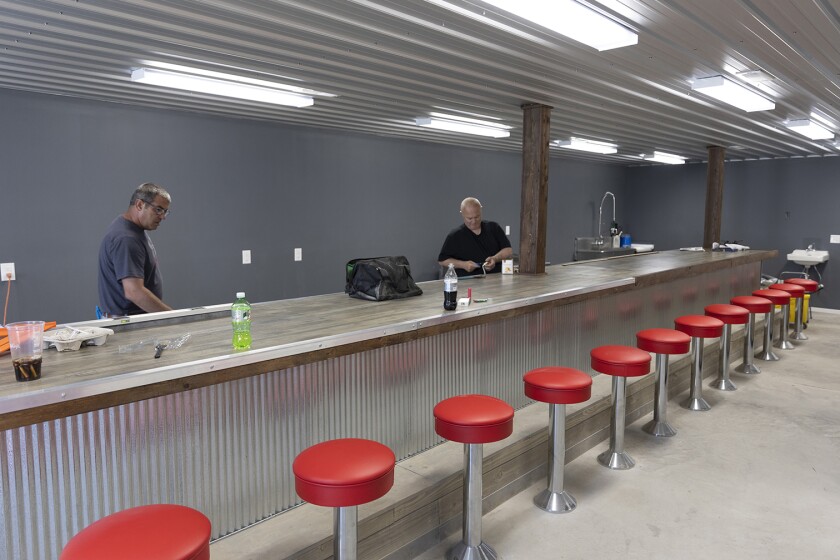
(David Kidd)
Mayfield’s no longer seeing the flood of volunteers that came in right after the storm, but the city’s still getting lots of help. Samaritan’s Purse, the international humanitarian aid group, has made a multiyear commitment to stay. Major donations have arrived from law firms from out of state and fast-food franchisers outside the county to rebuild parks and homes.
“It has been amazing,” O’Nan says. “If you’re going to have a disaster, have a bad one, because they get all the attention.”
A Deadly Path
It was freakishly warm on Dec. 10. Dozens of tornadoes touched down across nine states that night, destroying thousands of buildings and killing 89 people. In Edwardsville, Ill., about 150 miles north of Mayfield, six people died when an Amazon warehouse collapsed.
The tornado that struck Mayfield bore winds in excess of 200 miles per hour and stayed on the ground for 165 miles, one of the longest paths ever recorded. About 60 miles east, 14 people died in Dawson Springs, the hometown of the governor’s father and grandfather. A cousin and his wife were among the dead. “One block from my grandparents', there is no house standing,” Gov. Beshear tweeted. “It's heartbreaking.”
Continuing its deadly path, the storm killed 11 people in the town of Bremen, which had a population of 172 at the time of the 2020 census. Jordan Baize’s home was struck dead center. Checking the wreckage the next day, Baize sat down at his piano and played a hymn. His sister recorded him and the video went viral. This led to Baize making appearances on national TV shows and delivering countless testimonials in churches.
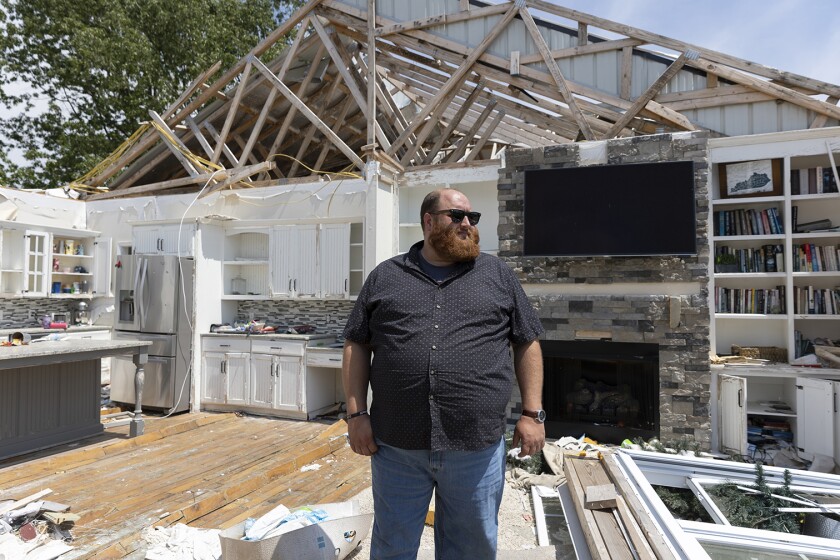
(David Kidd)
Baize’s brush with celebrity has helped him raise $70,000, which he intends to use to build community storm shelters. Just past his property line, a group of volunteers from a Bible church in Ohio are putting up a house under the auspices of a Virginia-based charity known as God’s Pit Crew. Five days after they started, the frame is up and they’re screwing in planks to construct the porch. “Some of them are carpenters,” says Tom Moro, a volunteer down from Akron, “and the rest of us just do what we’re told.”
People Growing Impatient
Along Water Street in Mayfield, a dozen teenagers from a Jewish high school in Brooklyn are working to clear a home site. “The human spirit is shining really brightly in Mayfield, Ky.,” Sims says as he drives by.
A few blocks away, a group of Amish volunteers from Indiana are putting some finishing touches on a home, part of a project known as Homes & Hope that’s set a goal of building 50 to 60 houses. Groups of about two-dozen volunteers come in for a week at a time, says Jordan Stettler, a beef farmer working on the project. “Right after a storm, everyone wants to help,” he says. “Now, people still want to help, but it’s slacked off.”

(David Kidd)
Committees have sprung up like wildflowers around the town. There are rebuilding committees and task forces, the city soliciting suggestions from residents about how they’d like to rebuild. Work is just starting on a master plan to rethink Mayfield and its design. “They’ve hired a national firm and a local firm to look at Mayfield to evaluate it, to make some decisions on do we go back exactly the way it was, or now that we have a clean slate do we make some modifications,” says Richard Heath, who represents Mayfield in the Kentucky House.
The wrecked courthouse was home to both county administrative offices and the jail. Those might be split up. Some one-way streets may be eliminated and some blocks might be taken out altogether, in order to make others wider. All of this is barely a work in progress, but it’s easy enough to find people around town who are unhappy about any and all potential land-use decisions.

(David Kidd)
Moving On
Not only the courthouse but Mayfield’s City Hall, a fire station, a police station and the water and power company were all wiped out. Heath remembers shopping for school clothes at the stores that surrounded the courthouse square when he was a kid. Now, he carries around a 19th-century hand-cut nail he picked up from the ruins of the courthouse the day after the storm.
“Reality has set in,” he says. “It’s here, and we have to deal with it.”
Despite the blow to civic infrastructure, city and county services have not missed a day. After setting up shop initially in a parking lot, city and county offices have moved temporarily out to Paris Road, Mayfield’s strip mall and fast-food area, left largely untouched by the storm. O’Nan’s office is next to a Verizon store, while the county offices are between Farmers Home Furniture and H&R Block.
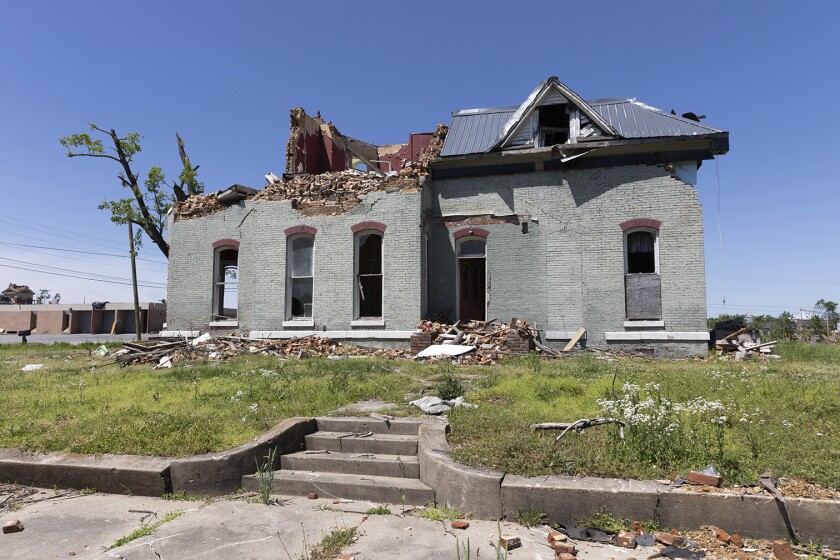
(David Kidd)
There seem to be fewer complaints about private insurance, but many people were only insured for fixed amounts, not the total cost of replacement and rebuilding. Those have shot up markedly, given inflation, supply chain problems and a shortage of contractors. Some haven’t collected enough to make it worthwhile to pay for clearing away the debris. The owner of a former hotel, the most prominent building left relatively intact downtown, sold it for $1, rather than spend $700,000 to take it down. There are some older people who took their insurance checks and decided to move on, rather than spend the time it takes to rebuild.
Anyone who has ever dealt with a contractor understands that construction inevitably takes longer than you’d hoped at the outset. “We've had a wet spring, so it's been tough to get footers dug and blocks laid and plumbing in and concrete slabs poured,” says Heath, who owns a building company. “The weather's just now where we can actually start doing some of that.”
Rain delayed construction on the third house that Bryce Steward is helping his father build along Fifth Street, just north of the courthouse square. Once it let up, it only took a few days for them to put up trusses and a roof. They plan to build several more homes. “Actually, since the storm, a lot has happened,” Steward says.
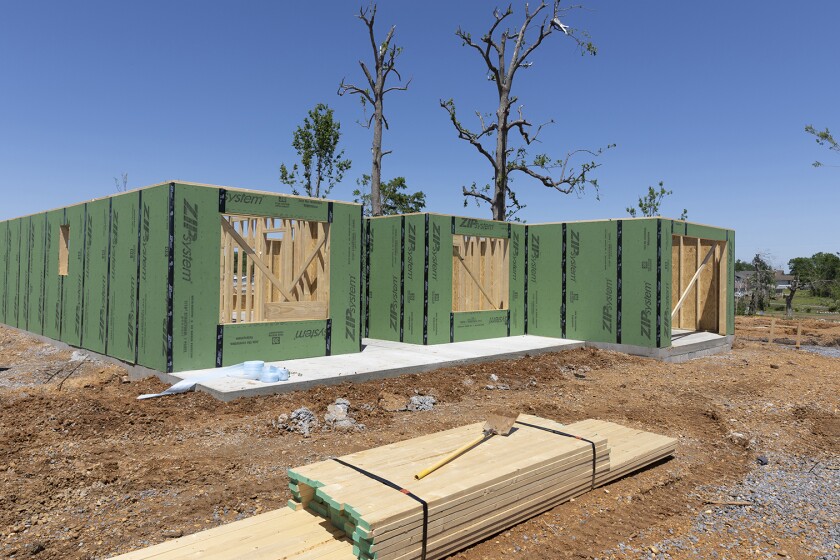
(David Kidd)
It's those kind of deep roots that make the mayor and other local officials optimistic that most residents will remain. O’Nan says she’s heard people say they didn’t realize how much they loved the town until it was almost gone. “I love seeing the excitement of people younger than I am — much younger than I am— about rebuilding this town.”
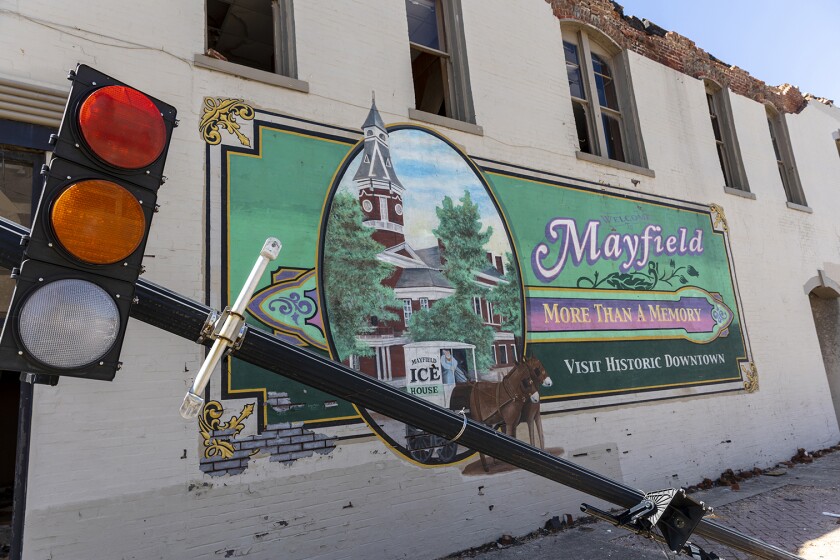
(David Kidd)
Related Articles














